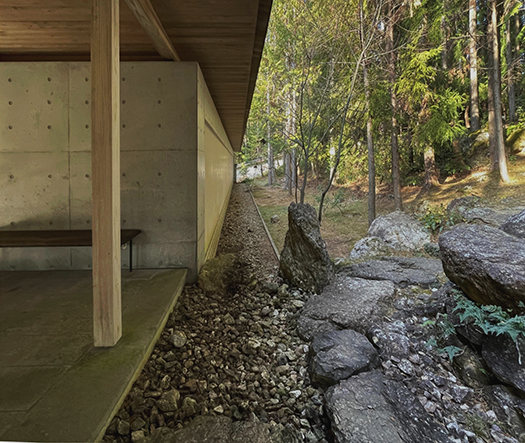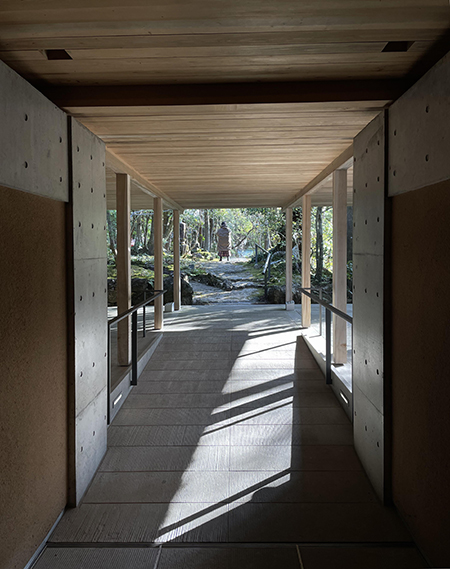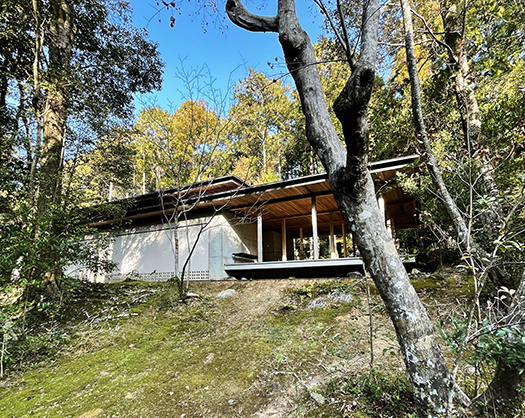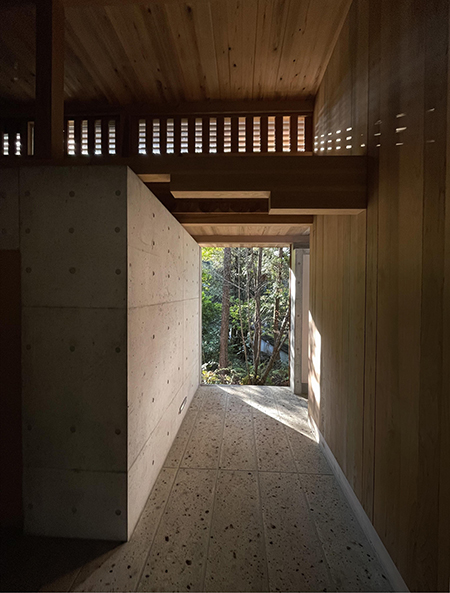


さて水盤のほのかな水音が支配するコンクリート空間からひとは離脱していくことになる。安藤忠雄「淡路夢舞台」でもちょうど時期的に童謡の「冬の夜」がホテルグランドニッコーによってBGMで流れていて、もう数ヶ月経っているけれど、まだ印象のなかに旋律が残っている。
こちらの納骨堂での水音は実際の水音としてではなく、映像的な音、というとおかしいのだけれど、そんな感覚の残滓が残っている。建築と音楽ということをこれまであんまり考えたことはなかった。
しかし司馬遼太郎の文章の中に、日本に最初に仏教寺院が開かれた当時、朝夕に繰り返される「念仏読経」の音楽性が、ひとびとの心に沈殿するように染みわたっていった、というくだりがある。それまで列島に暮らす人びとにとって、見たことも聞いたこともない「音楽体験」がいかに大きな役割を担っていたのか、と。それが伽藍で構成される宗教建築群と渾然一体で文化導入された。仏塔・五重塔という高層建築から回廊形式の内陣、外陣の空間仕分けなどの「曼荼羅」世界観が一気に仏教寺院建築空間で展開されていった。まさに度肝を抜かれるような世界観だったことだろう。
日本人のDNAレベルとも思える仏教受容には音楽性も含めた体験要素が大きく与っていた可能性がきわめて高い。インドや中国社会で仏教が廃れていったのに対して、日本社会がこの宗教文化を崇敬し続けたのにはとくに「空気を読む」情緒性レベルの高い民族としての日本人の心性が深い関係があったように思われる。あまりに巨大な「変革」要素には後世の人間はほとんど気がつかないものかもしれない。どうもそういった感覚に近いこととして、わたしには音楽要素の典型として水盤装置の印象が刻まれた。
納骨堂という鎮魂空間を彩る音楽性・建築性として水盤を選び取った感覚には深く同意する。

内観でも外観でも、コンクリート建築本体には木造で被覆が施されている。納骨室は法で耐火構造が求められる。屋根を構成する木造部はすべて県産材の杉105角。1995mmグリッドで構成。敷き並べたり積層させたりしている。まことに「正直」なその素材の表情が、鎮魂の場の空気感を高めてくれている。また無双窓からの採光と通気がこの地での鎮魂に彩りを加えている。
そしてやがて納骨堂から離れ、竹林寺の境内に移動していくけれど、ある種の回生にも似た気分を感じながら、日常に還っていく感覚があった。
English version⬇
Space for Requiem and “Musicality” Element Chikurinji Ossuary-5
The Japanese sense of “reading the air” may have been built up from a variety of experiences of Buddhism acceptance at the DNA level. …
Now, one leaves the concrete space dominated by the faint sound of water from the water basin. At Tadao Ando’s “Awaji Yumebutai,” a children’s song “Winter Night” was played as background music by the Hotel Grand Nikko just in time, and although several months have already passed, the melody still remains in my memory.
The sound of water in the ossuary here is not the actual sound of water, but a visual sound, or perhaps it is strange to say, but there is a residue of such a sensation. I have never really thought about the relationship between architecture and music.
However, in one of Ryotaro Shiba’s writings, he writes that when the first Buddhist temples were opened in Japan, the musicality of the “Buddhist chanting” repeated in the morning and evening seeped into people’s minds like a precipitation. It is said that the musicality of “Nembutsu Yomikyō,” which was repeated in the morning and evening at the time the Buddhist temple was first opened in Japan, played an important role for the people living in the archipelago, who had never seen or heard such music. This was introduced into the culture in tandem with the religious architecture of the temple complexes. The “mandala” worldview, from the high-rise architecture of stupas and five-story pagodas to the corridor-style inner sanctuary and outer sanctuary, was developed in the architectural space of Buddhist temples in one fell swoop. It must have been a truly astonishing worldview.
It is highly likely that the Japanese people’s acceptance of Buddhism, which can be considered to be at the level of their DNA, was greatly influenced by the experience of Buddhism, including its musicality. While Buddhism was dying out in India and China, Japanese society continued to revere this religious culture, which seems to have been deeply related to the Japanese mentality as a people with a high emotional level who “reads the air. The “change” factor is so enormous that it may be almost imperceptible to later generations. As something similar to such a feeling, I was left with the impression of the water-board device as a typical musical element.
I deeply agree with the sense that the water basin was chosen as a musical and architectural element to color the requiem space of the ossuary.
The concrete building body, both interior and exterior, is clad in wood. The ossuary is required by law to be fireproof. The wooden sections that make up the roof are all made of 105 square meters of prefectural Japanese cedar, with a 1995mm grid. The wood is laid out or stacked in layers. The truly “honest” expression of the materials enhances the atmosphere of the place of repose. Also, the lighting and ventilation from the twin windows add color to the repose of souls at this place.
Eventually, we left the ossuary and moved to the precincts of Chikurin-ji Temple, and I felt a sense of returning to my daily life, feeling a kind of reincarnation.
Posted on 3月 14th, 2023 by 三木 奎吾
Filed under: 日本社会・文化研究







コメントを投稿
「※誹謗中傷や、悪意のある書き込み、営利目的などのコメントを防ぐために、投稿された全てのコメントは一時的に保留されますのでご了承ください。」
You must be logged in to post a comment.